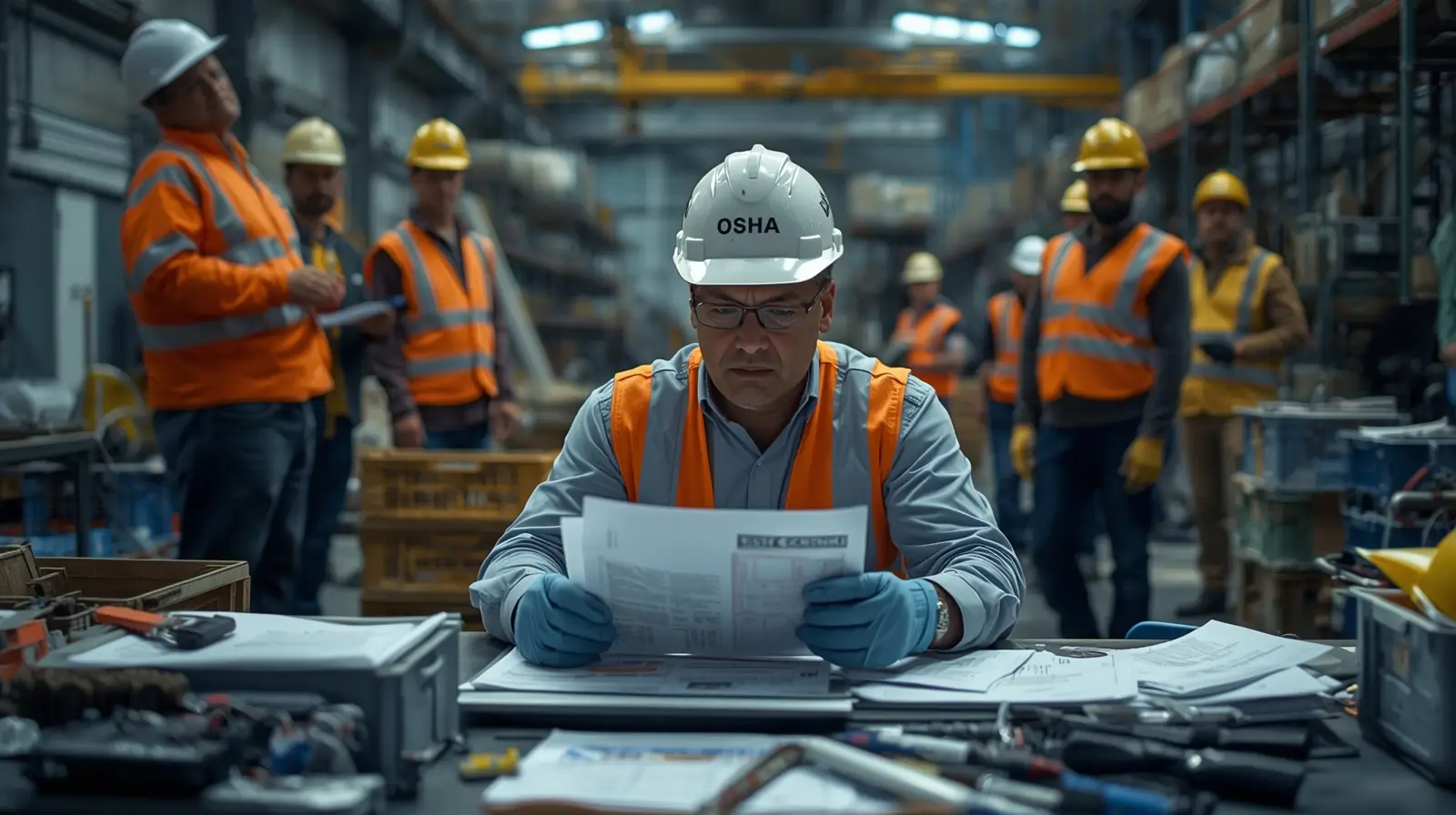OSHA Violation Rates Across the United States
When examining workplace safety enforcement across the United States, clear disparities emerge in OSHA violation rates between different states and regulatory systems. Data shows that state-run OSHA programs consistently record higher violations per inspection compared to federal OSHA, suggesting more thorough oversight or more widespread compliance gaps at the state level.
Federal OSHA Average
violations per inspection
State Plan Average
violations per inspection
Maryland
violations per inspection
For example, while federal OSHA averages around 0-0 violations per inspection, some state plans exceed 0-0 violations per inspection, highlighting major differences in workplace safety cultures and enforcement intensity. These findings underscore not just regulatory variance but also the heightened risks in certain regions where industries are more hazardous and compliance remains weaker.
This blog breaks down the states with the highest violation rates, explains why state-run programs uncover more issues, and outlines what employers need to know to stay compliant and avoid costly penalties. So, read on!
Key Findings: States with Highest Violation Rates
Recent OSHA data reveal that not all states experience workplace safety enforcement at the same level. A closer look shows clear outliers where violation rates are significantly higher than the national average. These findings provide valuable insights into how geography, industry type, and regulatory approach influence compliance outcomes.
State-Run OSHA Programs Uncover More Violations
States with their own OSHA-approved plans, such as California, Michigan, and Oregon, tend to report higher violations per inspection compared to federal OSHA. On average, state-run programs issue 0 violations per inspection, while federal OSHA averages just over 0 violations per inspection. This difference suggests that state inspectors may take a more detailed approach or that local industries present greater compliance challenges.
Industries Drive Regional Variations
Many of the states with elevated violation rates are home to high-risk industries such as construction, manufacturing, agriculture, and logging. For example, states with large agricultural economies often see higher violation rates due to hazards involving machinery, chemical exposure, and outdoor working conditions. Similarly, construction-heavy states face frequent fall protection, scaffolding, and electrical violations, some of the most cited hazards nationwide.
Top States Consistently Show Higher Non-Compliance
Year-over-year data indicate that certain states consistently rank above the federal average. These include states like Oregon, Washington, Alaska, and California, where violations per inspection regularly exceed 0, underscoring systemic compliance issues rather than one-off fluctuations.
Higher Violation Rates Don’t Always Mean Unsafe States
Importantly, higher violation rates do not necessarily imply that workplaces in these states are universally less safe. Instead, they often reflect more aggressive inspection practices, broader inspection scopes, and stronger enforcement cultures. In other words, inspectors in state-run programs may be more likely to cite multiple hazards in a single inspection compared to federal OSHA inspectors.
Employers Face Greater Scrutiny in Certain States
For businesses operating in these high-violation states, compliance obligations can be more demanding. Inspections are more likely to uncover multiple hazards, meaning employers must go beyond minimum compliance to avoid penalties. Understanding the enforcement landscape is crucial for companies managing worksites in different states.
States with Highest Violations Per Inspection
Some states consistently uncover more violations during inspections than the federal OSHA average, underscoring differences in enforcement rigor and workplace risk.
The latest data highlights several outliers where employers face heightened scrutiny.
OSHA Violations Per Inspection
OSHA Violations Per Inspection by State and System Type
The chart above illustrates the stark differences in violation detection rates, with state plans generally identifying more violations than federal OSHA operations.
Maryland
Maryland leads the nation with an alarming 4.8 violations per inspection, including 2.54 serious, willful, or repeat violations on average. This figure is more than double the federal OSHA average of roughly 2.3 and signals systemic safety issues across sectors such as construction, health care, and manufacturing.
North Carolina
North Carolina reports around 3.1 violations per inspection, exceeding both the federal OSHA average (2.3) and the state plan average (3.2). In FY 2018, the state conducted 2,444 inspections and cited 4,731 total violations, showing a combination of high inspection activity and high violation discovery rates.
Oregon
With averages above 3.5 violations per inspection, Oregon OSHA continues to reveal significant hazards in high-risk industries like logging, agriculture, and food processing. Inspectors in the state often cite multiple hazards in a single visit.
Alaska
Alaska typically records 3.4-3.6 violations per inspection, reflecting the dangers of industries such as fishing, oil extraction, and aviation. Extreme working conditions and isolated worksites further contribute to high citation rates.
California
Cal/OSHA maintains averages in the 0-0 violations per inspection range. With its diverse economy spanning agriculture, warehousing, and construction, California regularly cites violations tied to fall protection, heat illness prevention, and respiratory hazards.
Washington
Washington OSHA averages 0+ violations per inspection, with many citations linked to aerospace, maritime, and manufacturing operations.
Regional and State-Specific Patterns
OSHA violation rates are not evenly distributed across the country. Certain regions consistently demonstrate higher inspection activity and more frequent violation discoveries, often reflecting both the industrial mix and the enforcement culture of local OSHA offices.
Region 4 (Southeast States)
Alabama, Florida, Georgia, Kentucky, Mississippi, North Carolina, South Carolina, Tennessee
Region 4 has historically posted the highest violation patterns nationwide. Within this group:
Kentucky led the nation in inspections per capita in 2022, reflecting a strong focus on proactive enforcement. Tennessee and Georgia followed closely, both ranking third for inspections per capita and maintaining inspection activity well above the national average. North Carolina experienced a decline in inspection activity in 2022, though its historical violation rates remain consistently higher than the federal baseline.
California
45,000 inspections since January 2017
California conducts the highest absolute number of inspections nationwide. The state’s average penalty per violation stands at just $2,033, notably lower than states such as Texas ($3,240) and Florida ($3,566), suggesting that while more violations are identified, penalties may not be as financially burdensome.
These regional and state-specific differences emphasize that OSHA enforcement is not only about how often inspections occur, but also about how violations are cited and penalized. For employers, this means compliance strategies must account for both local inspection intensity and the potential financial impact of violations in their state.
Federal vs. State Plan Performance Differences
Federal OSHA and state-operated OSHA programs show notable differences in how many violations they uncover per inspection. While both aim to protect workers, the numbers reveal that state plans often take a more intensive approach to enforcement.
Federal OSHA
0 violations per inspection
Provides a national benchmark for workplace safety enforcement.
State Plans
0 violations per inspection
Reflects stricter oversight and more intensive enforcement compared to federal OSHA.
Most Active States
California, Oregon, Washington
Programs in these states conduct some of the highest inspection volumes nationwide.
Enforcement Approach
State plans are required to be at least as effective as federal OSHA, with many exceeding this standard through broader inspection scopes or stricter protocols.
Key Takeaway
Higher violation rates in state plans often signal more aggressive enforcement, not necessarily more dangerous workplaces.
High-Risk Industries and Violation Patterns
OSHA data makes it clear that certain hazards dominate inspections across the country, cutting across state lines and industry types. In 2024, the most frequently cited violations highlight the areas where compliance gaps remain most persistent and where workers face the highest risks.
Fall Protection General Requirements
0 violations
Fall hazards remain the number one safety issue nationwide, particularly in construction. Inadequate guardrails, lack of personal fall arrest systems, and poor site planning continue to drive these citations.
Hazard Communication
0 violations
This violation underscores ongoing issues with chemical labeling, employee training, and safety data sheets in industries like manufacturing, warehousing, and healthcare.
Ladders
0 violations
Improper ladder use, damaged equipment, and failure to follow safe climbing practices are frequent findings, especially on construction sites.
Respiratory Protection
0 violations
This category reflects gaps in fit testing, training, and equipment maintenance, critical in industries exposed to dust, fumes, or infectious agents.
Lockout/Tagout
0 violations
Failures to properly control hazardous energy during servicing or maintenance continue to cause serious injuries in manufacturing and industrial facilities.
Fatality data reinforces these patterns. Texas reported 0 workplace fatalities, the highest in the nation, followed by California with 0 fatalities. While these states have the largest workforces, they are also home to high-risk industries such as oil and gas, agriculture, construction, and logistics, sectors where the most-cited OSHA violations are especially relevant.
Taken together, these statistics reveal that while enforcement varies by state, the core hazards remain the same across the country. For employers, this means investing in fall protection systems, hazard communication programs, and energy control procedures is not just about compliance; it’s about addressing the risks most likely to result in citations, injuries, and fatalities.
Most Dangerous States for Construction Workers
Construction remains one of the most hazardous industries in the U.S., and state-level data shows that risks are not evenly distributed. By combining injury and fatality rates with OSHA enforcement trends, clear patterns emerge about where construction workers face the greatest dangers.
Most Dangerous States for Construction Workers
Construction remains one of the most hazardous industries in the U.S., and state-level data shows that risks are not evenly distributed. By combining injury and fatality rates with OSHA enforcement trends, clear patterns emerge about where construction workers face the greatest dangers.
Tennessee
Ranked as the most dangerous state for construction workers in 2024, Tennessee reports high rates of injuries and fatalities relative to its workforce size. Frequent violations of fall protection requirements and unsafe scaffolding practices drive much of the state’s risk profile, despite ongoing enforcement efforts.
South Dakota
Coming in second, South Dakota’s smaller workforce size makes its fatality rate particularly alarming. Limited inspection resources and the prevalence of high-risk construction sectors, such as heavy highway and industrial building projects, contribute to its elevated danger rating.
California
Although California has one of the most active OSHA programs in the country, its vast construction workforce means absolute numbers of injuries and fatalities remain high. Heat illness prevention, fall hazards, and trenching violations are recurring issues on job sites statewide.
Florida
Ranked eighth, Florida demonstrates that inspection activity alone does not always guarantee safer outcomes. With 0,0 OSHA inspections recorded, the state still struggles with widespread fall protection violations and the added challenge of heat-related illnesses in outdoor construction.
These findings reveal that the “most dangerous” states are not always those with the weakest enforcement systems, but rather those where a combination of industry mix, climate factors, and safety culture exacerbate risks. For construction employers, this underscores the need to move beyond compliance minimums, implementing robust fall protection systems, heat safety programs, and site-specific safety planning to reduce the high rates of injuries and fatalities that continue to plague the sector.
Penalty and Enforcement Intensity
Beyond inspection frequency and violation rates, the financial penalties imposed by OSHA reveal how aggressively different states enforce workplace safety standards. Average penalty amounts vary widely, often reflecting both the severity of violations uncovered and the enforcement culture of state OSHA offices.
Florida
Average penalty: $0 per violation
Florida imposes some of the highest financial consequences in the country. This aligns with the state’s ongoing challenges in construction, where fall protection and heat-related violations are frequent.
Texas
Average penalty: $0 per violation
Texas demonstrates a similarly tough enforcement stance, particularly in industries such as oil and gas, construction, and logistics.
Alabama, Georgia, and Mississippi
Average penalties: $0+ per violation
These states highlight a pattern across the Southeast where higher penalties are paired with elevated violation discovery rates.
California
Average penalty: $0 per violation
Despite leading the nation in total inspections, California’s average penalty sits considerably lower than other large states. This suggests that while California identifies more hazards overall, the financial impact of citations is less severe compared to places like Florida and Texas.
These variations indicate that in states where violation rates are persistently high, regulators often impose steeper penalties to drive compliance. For employers, this means the cost of noncompliance is not uniform across the U.S.; businesses operating in multiple states must account for both the likelihood of being cited and the financial consequences that follow.
Severe Injury Reporting Patterns
From 2015 to 2024, OSHA’s severe injury reports highlight where construction workers face the most catastrophic risks. These incidents, such as amputations, hospitalizations, or loss of an eye, offer a direct measure of job-site hazards.
Texas
0 severe injuries reported
Texas has consistently reported the highest number of severe injuries, reflecting both its large construction workforce and persistent safety challenges.
Florida
0 severe injuries reported
Florida has ranked second, with heat exposure and fall-related accidents as recurring contributors.
Pennsylvania
Pennsylvania is placed third, driven by incidents in heavy industrial and urban construction projects.
Ohio
Ohio came fourth, with machinery-related injuries prominent in reports.
Illinois
Illinois rounded out the top five, often linked to dense metropolitan construction activity.
These patterns reveal not only the scale of construction activity in these states but also gaps in hazard prevention strategies, showing where the risks of life-changing injuries remain most concentrated.
Regional and Industry-Specific Challenges
Southeastern states consistently rank high in both violation rates and hazardous working conditions.
The region’s strong presence of construction, manufacturing, and agricultural industries contributes to these elevated risks.
California presents a unique case: despite being the most inspection-active state, it remains the third-most dangerous for construction workers.
This paradox reflects the complexity of workplace safety in a state with a vast workforce and diverse industries.
State-run OSHA programs also detect more violations per inspection than federal oversight, suggesting either more rigorous enforcement or more deeply rooted workplace hazards.
Southeast
High-risk industries drive violation and injury rates.
California
Intensive inspections, yet significant hazards persist.
State-Run Programs
Uncover more violations than federal inspections.
Understanding these regional and industry-specific dynamics is crucial for companies operating across states and for policymakers shaping the next phase of workplace safety regulation.
Wrap Up
OSHA data shows that workplace safety risks vary widely across states, with certain regions and industries facing higher violation rates and penalties. For employers, the key takeaway is clear: staying compliant isn’t just about avoiding fines, it’s about protecting workers and building a stronger safety culture.










